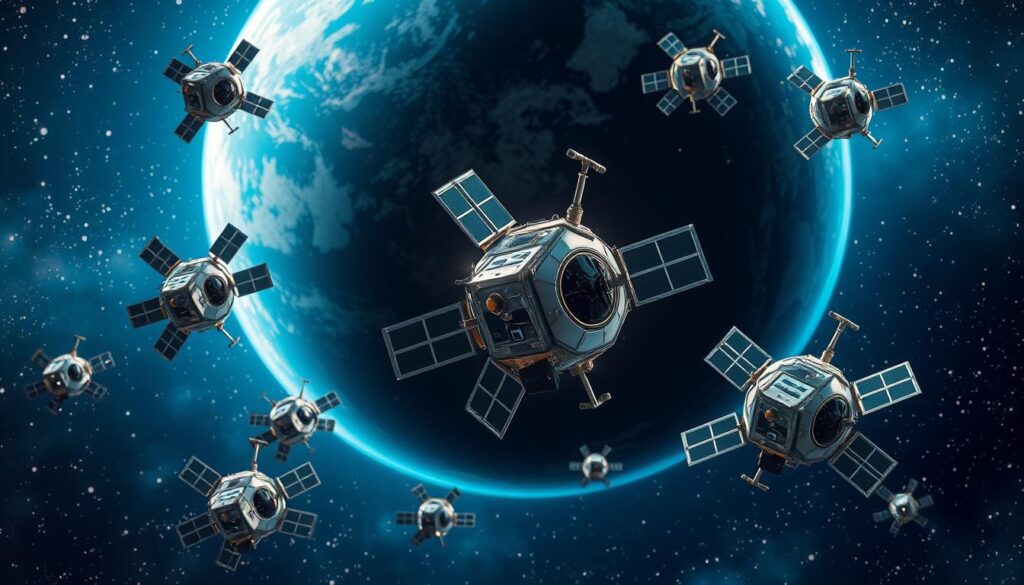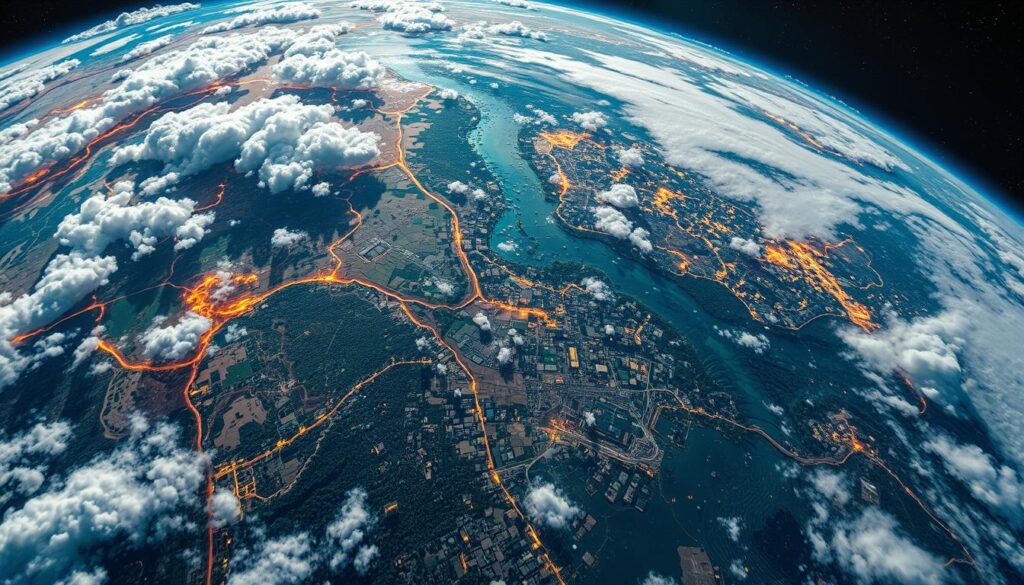“As an Amazon Associate I earn from qualifying purchases.” .
When we look up at the stars, we feel a sense of wonder. The stars twinkling above are not just stars; they have satellites working with them. These satellites are changing how we see space and connect with the world.
Satellite technology is evolving fast and touches our lives every day. It helps us with GPS and weather forecasts. Over 10,000 private companies and 5,000 investors are making big strides in space.
NASA is leading the way in space exploration and science. This new space race is not just about reaching other planets. It’s about using satellites to solve problems and connect people everywhere.
We’re diving into the world of satellite technology. These satellites are making communication, navigation, and Earth observation better. We’re entering a new era in space, and it’s happening right before our eyes.
Key Takeaways
- Satellite technology is revolutionizing global connectivity and Earth observation
- The space industry includes over 10,000 private companies and 5,000 investors
- Small satellites now make up 94% of all spacecraft launches
- Commercial space activity has tripled from $110 billion to $357 billion since 2005
- Emerging trends include Satellite IoT, AI integration, and in-orbit services
The Evolution of Satellite Technology
Since the early days of space exploration, we’ve made huge strides. In 1957, the Soviet Union launched Sputnik 1, the first man-made satellite. This event started a new era in space travel and communication.
This achievement led to fast growth in satellite technology and how we use space. It changed the way we talk and explore the universe.
From Sputnik to Modern Satellites
From the first Sputnik to today’s advanced satellites, we’ve seen incredible progress. In 1958, SCORE was the first satellite to send messages, carrying a message from President Eisenhower. By 1962, Telstar made it possible to broadcast live across the Atlantic, changing global communication forever.
Key Milestones in Satellite Development
Here are some major steps in satellite technology:
- 1960: Courier, the first fully active communications satellite, was launched.
- 1965: Early Bird started continuous service as the first commercial satellite.
- 1976: Marisat introduced mobile satellite services for ships at sea.
- 2003: Eutelsat’s e-BIRD brought broadband internet to remote areas in Europe.
- 2010: ViaSat-1 set a record as the most powerful satellite at the time.
The Role of NASA and Other Space Agencies
Space agencies have been key in improving satellite technology. NASA, created in 1958, leads in space exploration and satellite tech. Agencies like the ESA and CSA have also greatly helped with improving how we use space and connect with satellites.
| Year | Achievement | Impact |
|---|---|---|
| 1957 | Launch of Sputnik 1 | Began the Space Age |
| 1962 | Telstar enables live transatlantic telecast | Revolutionized global communication |
| 1976 | Introduction of Marisat | Enabled mobile satellite services |
| 2021 | Over 500 satellites in geostationary orbit | Expanded global connectivity |
Now, we’re entering a new phase with nanosatellites and big constellations like SpaceX’s Starlink. These new technologies will likely change how we connect and explore space even more.
Small Satellites: Revolutionizing Space Exploration

Small satellites are changing the way we explore space. They are making space travel cheaper and more accessible. The market for these small satellites was worth $3 billion in 2022 and is expected to grow to $13.2 billion by 2032.
These small satellites are impacting many areas in space technology. They are much cheaper to launch because they are smaller and lighter. Launch costs have dropped from up to $400 million to around $60 million, thanks to companies like SpaceX.
Smallsats offer more than just cost savings. They can be used to create large networks in space. These networks provide better communication and Earth observation across the globe.
“Small satellites are not just miniaturized versions of their larger counterparts. They represent a paradigm shift in how we approach space exploration and utilization.”
Advanced technology in small satellites is key to their success. They can do complex tasks despite their small size. Small satellites are now used for tasks like Earth imaging and monitoring space weather.
The future looks bright for small satellites. The global space market is expected to hit $1879 billion by 2032. These small satellites will play a big part in our exploration of space. Advances in microelectronics and battery technology will make them even more useful for space missions.
Satellite Technology Advancements: Driving Innovation
We’re seeing a big change in satellite technology. The space industry is moving fast, with new ideas changing how we explore and use space. Innovations like smaller parts and AI are changing our space and Earth watching ways.
Miniaturized Components and Improved Efficiency
Smaller, more efficient satellite parts have changed the game. These let us make smaller satellites that do a lot. The Space Enterprise Consortium (SpEC), started in 2017, helps space startups and old aerospace companies innovate.
Advanced Propulsion Systems
New ways to move through space are being tested. Technologies like nuclear propulsion, solar sails, and ion thrusters could make getting to other planets faster and cheaper. This could open up new areas for science and business in space.
AI and Machine Learning in Satellite Operations
Artificial intelligence and machine learning are changing how satellites work. They’re key for handling big data sets from space missions. AI helps spot patterns, predict space events, and make operations better.
| Technology | Application | Impact |
|---|---|---|
| Miniaturized Components | Compact Satellites | Increased Efficiency, Cost Reduction |
| Advanced Propulsion | Deep Space Exploration | Faster Travel, Extended Mission Range |
| AI and Machine Learning | Data Processing, Mission Optimization | Improved Decision Making, Enhanced Scientific Insights |
These advances in satellite tech are pushing us to do more in space. They’re also making our geospatial imaging and remote sensing better. As we keep exploring, the future of satellite tech looks very promising.
Earth Observation and Remote Sensing Breakthroughs
Earth observation has changed how we see our planet. In 2013, only 10 new satellites were launched for Earth observation. By 2022, over 200 new satellites joined the sky. Now, more than 1,000 satellites orbit Earth, giving us valuable data.
Remote sensing has moved the industry forward. The Earth Observation market was worth $3.7 billion in 2023. It’s expected to grow to $6.5 billion by 2033. This growth comes from better geospatial imaging and data analysis.

Now, satellite constellations with advanced sensors offer real-time data. This data helps with tracking assets, monitoring the environment, and surveillance. The rise in Earth observation data has also boosted data analytics and machine learning. This has led to new insights in various industries.
| Year | EO Satellites Launched | Market Value |
|---|---|---|
| 2013 | 10 | Less than $1 billion |
| 2022 | 200+ | $7 billion |
| 2023 | 1,000+ in orbit | $3.7 billion |
| 2033 (projected) | N/A | $6.5 billion |
These technologies have huge potential. For example, Planet Labs used AI to quickly identify tree height and type from massive images. This would have taken a human analyst 7 years to do.
“Earth observation and remote sensing technologies are not just observing our planet; they’re helping us understand and protect it in ways we never thought possible.”
Satellite Communication: Connecting the World
We’re seeing a big change in satellite communications. Our world is getting more connected, and satellites are key to closing the digital gap. They help us stay connected across the globe.
5G and Beyond: The Role of Satellites
Satellites are taking us into the future of 5G and more. Low Earth Orbit (LEO) satellites are changing the game. They move fast, offering speeds that make 5G networks work better.
These satellites are almost 25 times faster than sound. This means they can send data in less than 20 milliseconds. This speed is vital for 5G and the growth of wireless tech.
Learn more about wireless communication technologies
Bridging the Digital Divide
Satellite tech has made a huge impact on global connectivity. From 2010 to 2020, internet users doubled to over 4 billion. Satellites are key to this growth, helping in areas like farming, logistics, and more.
Internet of Things (IoT) and Satellite Integration
Satellites and IoT are changing how we connect in remote places. High Throughput Satellites (HTS) are making broadband internet better. They offer more data and are very reliable, lasting up to 20 years.
| Satellite Type | Altitude (km) | Latency |
|---|---|---|
| LEO | 500 – 1,200 | <20 ms |
| MEO | 10,000 – 20,000 | ~50 ms |
| GEO | 35,786 | ~220 ms |
Looking ahead, new tech like quantum key distribution and software-defined satellites will improve our global networks. Adding AI and machine learning to satellites will make them smarter. This will help us create a world where everyone is connected.
Space-Based Data Analytics: Unlocking New Insights
Space-based data analytics is changing the game for industries worldwide. In 2020, the satellite data services market was worth $6 billion. By 2030, it’s expected to hit $45 billion. This shows how valuable insights from space are becoming in our data-driven world.
There’s a big move from focusing on satellite hardware to using data in new ways. This change has led to new business models and more innovation in handling satellite data. The space world is now moving towards a shared global network, blending public and private sectors.
AI in space tech is key to managing the huge amount of data from satellites. Advanced AI algorithms turn raw data into useful insights. This helps industries like farming, energy, and logistics.
“The future of space exploration lies not just in satellites, but in the insights we derive from the data they collect.”
Let’s see how space-based data analytics is changing different industries:
| Industry | Application | Impact |
|---|---|---|
| Agriculture | Precision farming | Improved crop yields, efficient resource use |
| Logistics | Real-time tracking | Optimized routes, reduced delays |
| Environmental Conservation | Deforestation monitoring | Better forest management, wildlife protection |
By using space-based data analytics, we’re unlocking new insights that could change our world. The next step is to develop strong data systems and address privacy concerns. This will help us fully use this vast source of information.
In-Orbit Servicing and Debris Management
We’re entering a new era with big steps in in-orbit servicing and managing space debris. These changes are changing how we keep and extend the life of satellites. They help make space cleaner and more sustainable.
Extending Satellite Lifespans
In-orbit servicing is changing how we maintain satellites. The MICE project, led by GMV with AVS, has improved the technology readiness level to 8. This means satellites can keep working even after they were meant to stop, lasting up to 12.5 years.
Addressing the Space Debris Challenge
Managing space debris is key to keeping space safe. The Active Debris Removal Vehicle (ADRV) has reached TRL 6, showing it can work in real situations. It can remove big pieces of debris weighing 1000 to 4000 kg at heights from 200 to 2000 km.
Robotic Maintenance in Space
Robotic tech is changing how we fix satellites. NASA has made a system to catch, fix, and remove Earth satellites with robots. It uses LiDAR for finding and measuring satellites, making repairs and upgrades quicker than before.
These steps in in-orbit servicing, managing space debris, and fixing satellites are leading to a sustainable future in space.
The Commercial Space Race: New Players and Opportunities
The commercial space industry is booming. It’s now worth $546 billion and could hit $1.1 trillion by 2030. This growth has drawn many private companies and investors, changing space exploration.
There’s a big jump in funding for space startups. In three years, funding went from $3.5 billion to $15 billion, a 329% increase. This money is driving innovation and expanding space possibilities.
Space tourism is becoming a big deal. Wealthy people are eager to experience space, offering new chances for companies.
Companies are now spending a lot on space research and development. Ten years ago, they spent about $1 billion. Now, it’s $5 billion to $6 billion a year.
| Year | Private Sector R&D Spending | Market Size |
|---|---|---|
| 2013 | $1 billion | $339 billion |
| 2023 | $5-6 billion | $546 billion |
| 2030 (Projected) | Not available | $1.1 trillion |
More countries are joining the space race. Over 80 are now part of it, making the market diverse and competitive. This global effort is pushing innovation and creating new chances for working together in space.
Ethical Considerations and Space Governance
As we explore space, managing it becomes key. Satellites bring new issues to space travel. We must work together to solve these ethical problems.
International Cooperation in Space
Space brings nations together. The International Space Station shows this, being a lab in space for the world. With 102 countries talking about space ethics, we’re making progress.
Sustainable Space Exploration
We’re making a bigger mark in space. Last year, we added 2,470 objects to orbit. SpaceX now has over 5,500 satellites, helping millions. But, this growth worries us about space junk and safety. We need to act to keep space safe for the future.
Addressing Space Militarization Concerns
The space market is growing fast, expected to hit $700 billion by 2030. This makes us worry about military use in space. The UN wants to set rules for space use. We aim for peaceful space use and responsible rules.
| Challenge | Solution |
|---|---|
| Space Debris | Debris removal technologies |
| Satellite Crowding | Space traffic management |
| Resource Extraction | Sustainable mining practices |
| Militarization | International treaties |
Working together, we can make space exploration bright and ethical. This way, we keep standards high and support global cooperation.
Future Prospects: The Next Frontier in Satellite Technology
The future of satellite technology is full of exciting changes. We’re entering a new era in space exploration with big innovations. Next-generation satellites will change how we communicate, watch our planet, and explore space.
Artificial intelligence and 3D printing are leading this change. These technologies will make satellites more adaptable and efficient. Soon, satellites might change their shape in space to take on new tasks!
Quantum communication is another big leap. Future satellites might use quantum systems for super-secure global networks. This could make our online world much safer from threats.
“The next frontier in satellite technology will not just change space exploration, but life on Earth as we know it.”
Space-based solar power and asteroid mining are becoming real. These technologies could solve our energy and resource problems. As we explore new possibilities, satellites will be key in tackling global issues like climate change.
| Technology | Potential Impact |
|---|---|
| Quantum Communication | Ultra-secure global networks |
| Space-based Solar Power | Clean, unlimited energy |
| Asteroid Mining | Abundant resources for Earth |
| AI-powered Satellites | Self-adapting space missions |
The future of satellite technology is not just about space. It’s about making a better world for us here on Earth. As we gaze at the stars, we’re also finding ways to protect our planet and enhance life for everyone.
Conclusion
Satellite technology has come a long way since Sputnik 1 launched in 1957. Today, we see the impact of these innovations worldwide. They’ve changed our world in ways we couldn’t imagine.
Now, we have reusable rockets and private space companies. Space exploration is open to more people than ever before.
The economic benefits of space exploration are clear. It has brought in a lot of money and helped many areas like materials science and medicine. Technology has changed old practices, just like AI is now used in new ways.
This sharing of ideas leads to new innovations. It creates jobs and helps the economy grow.
Looking to the future, we have big challenges and chances. We aim to send humans to the Moon, asteroids, and Mars. This will expand our knowledge and abilities.
We also face issues like space debris and sustainable exploration. These efforts help us and protect our planet. The future of satellite technology looks bright.
It will connect us, bridge digital gaps, and help solve global problems. We’re writing a new chapter in history, one satellite at a time.
FAQ
What is the role of NASA and other space agencies in advancing satellite technology?
How are small satellites revolutionizing space exploration?
How are satellite technology advancements driving innovation across various sectors?
What breakthroughs have been made in Earth observation and remote sensing technologies?
How is satellite communication playing a role in global connectivity?
How is space-based data analytics unlocking new insights?
Why are in-orbit servicing and debris management important for satellite technology?
How is the commercial space race impacting the satellite industry?
What ethical considerations are important as satellite technology advances?
What future prospects are there for satellite technology?
“As an Amazon Associate I earn from qualifying purchases.” .



